Long-Eared Owl
Crosswicks Creek Greenway
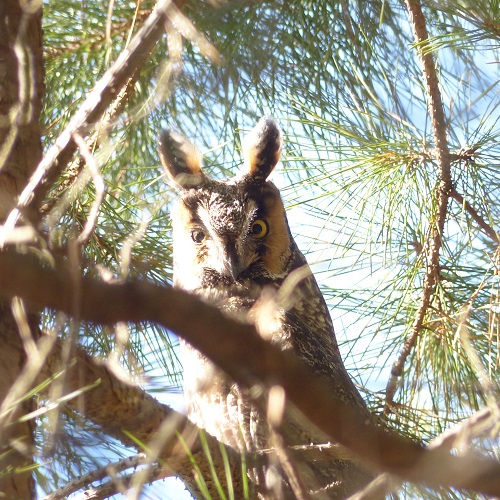
The Long-eared Owl is a now considered a winter visitor to New Jersey. At first glance this bird appears very similar to a Great Horned Owl. The long-eared owl is, however, much smaller, weighing in at just under a pound and with a 33 to 36 inch wing span. The “ear tufts” are much longer and more centrally located on top of the head. This strictly nocturnal owl is much more secretive than the Great Horned Owl and can be very difficult to locate. This species is considered “Threatened” in New Jersey and breeding pairs are scarce, if they still breed in the state at all. The loss of suitable nesting habitat due to development and changes in agricultural practices are partly responsible for the decline in the population. Its low pitched “hoo” note can be heard about one kilometer away and these owls are generally quiet outside of the mating season. (Posted 12/14/18.)
November Birding
Fall is a great time of year to get outside and look for wildlife, specifically birds. Lots of birds are out feeding as they migrate through the area. Some birds we are getting the last glimpses for the year and other birds are just arriving for the season. It’s a great time to brush up on your bird IDs by checking out what the fall plumage for birds will be in our area, adding a fun challenge to bird identification.

Ruby Crowned Kinglet, Regulus calendula, at the Manasquan Reservoir Environmental Center seen hopping and feeding inside a sweet pepper bush, Clethra alnifolia.
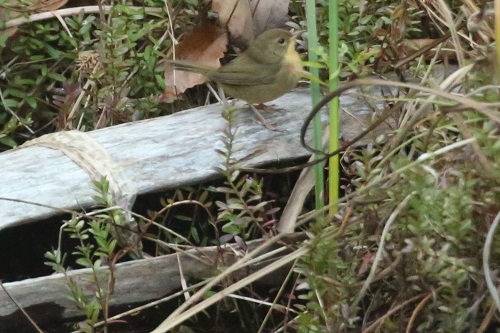
A difficult ID to make for most beginner birders is this immature female Common YellowThroat, Geothlypis trichas, at the Manasquan Reservoir Environmental Center front pond.
A Pileated Woodpecker, Dryocopus pileatus, was spotted along the trail at the Manasquan Reservoir with its mate.
White-throated Sparrow, Zonotrichia albicollis, found foraging for food among the leaves at the Manasquan Reservoir.
Love taking photos of nature? Why not submit an application (or two) for our photography exhibits at Deep Cut Gardens and the Manasquan Reservoir Environmental Center. Both exhibits are using The Cycle of Life theme. Youth, amateur adult and professional divisions. The deadline to enter is December 15th.
Red-Breasted Nuthatch at Seven Presidents Oceanfront Park
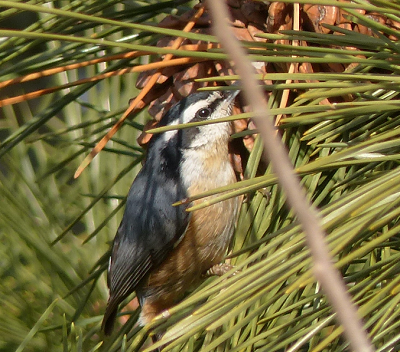
A visit to Seven Presidents County Park, Long Branch, just might get you a close look at this little Red-breasted Nuthatch. Spotted there amongst a few others of its own kind, this small bird can be easily identified by its white and black striped head, bluish-gray back, and cinnamon-colored breast. (posted 12/6/2018)
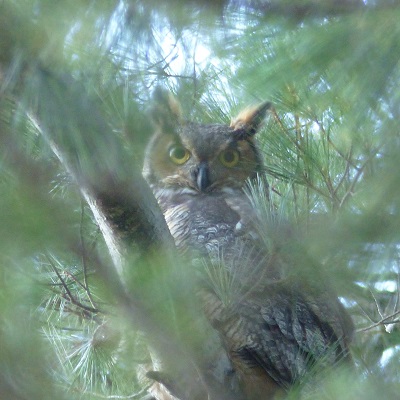
This is the time of year to look for Great Horned Owls as there are fewer leaves on the trees and it makes them easier to spot. The birds also start searching for lifetime mates and setting up nesting territories so they are very active and very vocal. The typical “WhooWhooWhooing” easily identifies these large nocturnal and sometimes crepuscular raptors. The Great Horned Owls do not build their own nest, but prefer to take over an abandoned hawk’s nest, crow’s nest, osprey’s nest, or even an unattended bald eagle’s nest. They may also make use of a large hollow in a tree. The Great Horned Owl is a year-round resident in Monmouth County and can be found in all of our heavily wooded parks. They have one brood per year, laying one to four eggs between late January and early March. With a 44 inch wing span and a average weight of 3.1 pounds, they are considered apex predators.
In this photo, a murder of crows was creating a large fuss high in a pine tree drawing attention to this owl. It was photographed at the back of the Huber Woods Environmental Center around 8 a.m. (Posted 12/05/18)
Hydrilla at Manasquan Reservoir
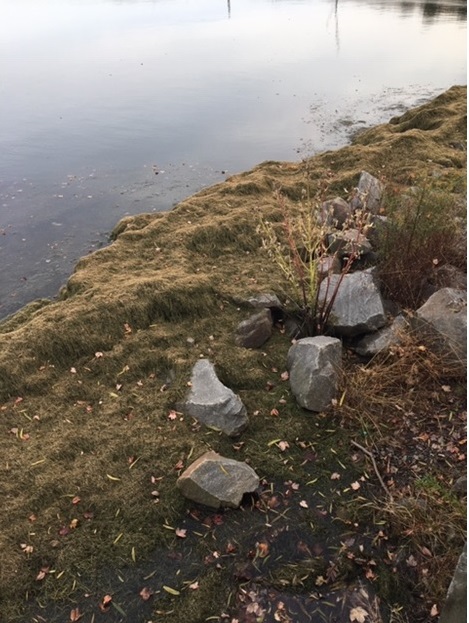
Some of our visitors have noticed what looks like dead grass on the Reservoir’s causeways and floating in the Reservoir itself. What they are seeing is the highly invasive aquatic plant hydrilla (Hydrilla verticillata). During the fall, the hydrilla senesces (deteriorates with age) and prevailing winds blow it toward the shoreline. Our partners, the New Jersey Water Supply Authority, who manage the Reservoir’s water, dam, and other structures, are actively working to manage this aggressive plant and control its spread. Boaters can do their part in controlling the spread of hydrilla and the Authority has created a website on how you can help - www.njwsa.org/how-you-can-help.html. (posted 11/16/2018)
Hey...Who is That?
I am always hoping to see a rare or unusual bird and migration season is a good time to be on the lookout. An experienced birder once told me that a good place to spot an uncommon bird is within a flock of migrating, common birds. So, every spring and fall I get out my binoculars and scan flocks of Canada Geese, Brant, Starlings, Cowbirds and more. This past week I got lucky! A flock of sleeping Rudy Ducks caught my eye and, as I scanned through them, someone looked different – a little bigger than the rest.
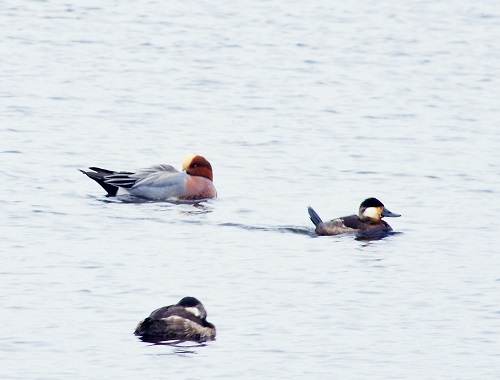
I pulled out the binoculars and sure enough, there was a stranger with the flock! I took a few photos to use once I got home and could pull out my bird book. Bingo! A Eurasian Widgeon. A new bird for my life list and an uncommon visitor to Monmouth County.
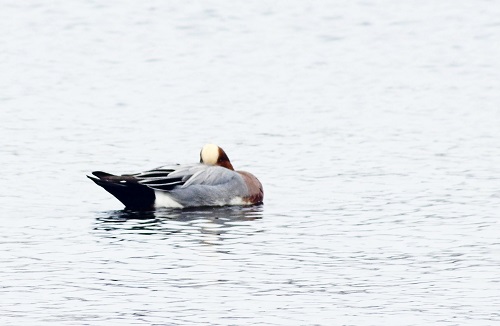
Eurasian Widgeons are native to Europe and Asia, migrating seasonally between the two. While there are rare sightings of these beautiful birds in North America each year, they are not considered native to the New World and there have been no records of them breeding here. There have been some reported cases of them interbreeding with American Widgeons. The Eurasian Widgeons seen here are likely from eastern Siberia or Iceland. There are only three species of widgeon in the world, the Eurasian Wigeon (Mareca penelope), the American Wigeon (M. americana) and the Chiloé Wigeon (M. sibilatrix). The males of all three are very colorful while only the females of the Chiloe Widgeon are also. They are dabbling ducks, eating from the bottom of shallow water by tipping their heads down rather than diving. Therefore, a good place to look for Widgeons is along the edges of shallow water.
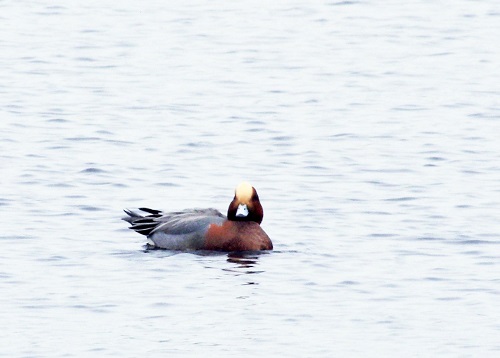
The next time you are able to observe a flock of migrating birds, scan the flock. Look for an individual that is slightly larger or smaller, has different color feet or beak or just looks different from the others. You might get lucky and spot a new bird for your life list! (posted 11/7/2018)
Black Vulture (Coragyps atratus)
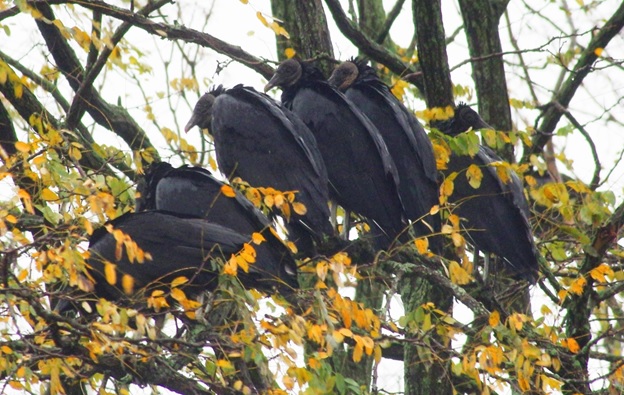
Behold, a committee of black vultures resting on a tree branch between meals (spotted at the Sunnyside Equestrian Center). During feeding, a group of vultures is called a wake, while the birds when circling around are referred to as a kettle. Due to their poor sense of smell, black vultures often follow the olfactorily-gifted turkey vultures to carcasses. Once there, these vultures have been seen to band together and secure their new food supply. (posted 11/7/2018)
Highlighting of Fall Sightings
October is a beautiful time of year - the leaves are falling, the temperature is beautiful, and lots of creatures are on the move. It is also a great time of year to go out birding as birds are starting to migrate south for the winter and head to warmer weather. It’s the perfect time to see fall warblers, birds of prey, and wintering ducks.
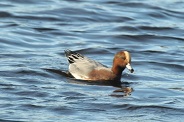
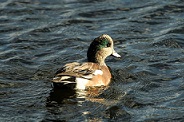
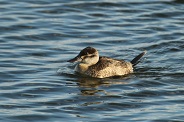
PICTURED - An Eurasian Wigeon, Mareca penelope, spotted at Lake Como on October 25 (left); an American Wigeon, Mareca americana, spotted at Silver Lake in Belmar on October 24 (center); and a Ruddy Duck, Oxyura jamaicensis, one of the first winter duck migrants to arrive in Monmouth County, at the Manasquan Reservoir on October 24 (right).
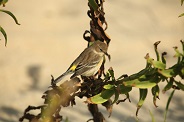
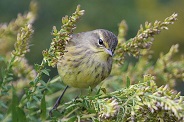
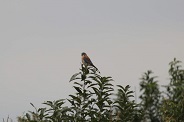
PICTURED – A Yellow Rumped Warbler, Setophaga coronata, the only wintering warbler of New Jersey spotted in large numbers, at the Shark River Inlet in Belmar on October 22 (left); a Palm Warbler, Setophaga palmarum, at Assunpink Wildlife Management Area on October 14 (center); and an American Kestrel, Falco sparverius, spotted at Assunpink Wildlife Management Area on October 14 (right).
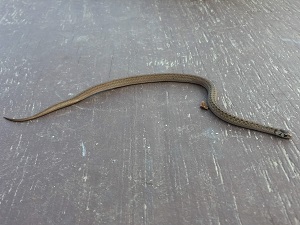
PICTURED – A Northern Brown Snake, Storeria dekayi, found at Huber Woods during the stage set up for the Creatures of the Night program on October 19.
PICTURED - A Northern Watersnake, Nerodia sipedon, found at the Manasquan Reservoir on October 17 (left); a Northern Slimy Salamander, Plethodon glutinosus, found at Huber Woods by Park System Naturalists Blake Beyer, Ruth Carll, and Paul Mandala on October 2 (right).
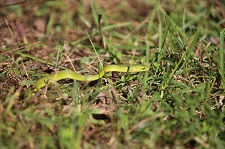

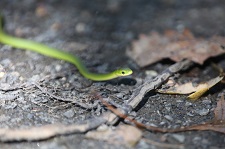
PICTURED - A Rough Green Snake, Opheodrys aestivus, found at the Manasquan Reservoir after being moved off trail on October 17 (left); Park System Naturalist Blake Beyer holding a rough green snake, Opheodrys aestivus, found sunbathing on the Bracken Trail at the Manasquan Reservoir Environmental Center on a warm October day before being relocated to a safe location (center); and a Rough Green Snake, Opheodrys aestivus, on the Bracken Trail of the Manasquan Reservoir Environmental Center on October 17 (right). (posted 10/30/2018)
Bald Eagle Release
You never know what you might see during one of our free drop-in programs! This video was taken by a lucky participant on our Casual Birder program this morning. An injured juvenile male Bald Eagle was found in early September in Monmouth Beach. It was rehabilitated at The Raptor Trust and released by state officials today (October 18, 2018) at Hartshorne Woods Park, Middletown. (posted 10/18/2018)
Fungi of Perrineville Lake Park
This week on our Awesome Autumn Amble, the forest was covered with many different types of fungi. These three examples below are all members of the Polypore group, their signature characteristic being a harder cap called a Conk. Polypores typically grow on or nearby dying or dead trees, and are a vital part of nutrient recycling in a forest!
Turkey Tail or Trametes versicolor
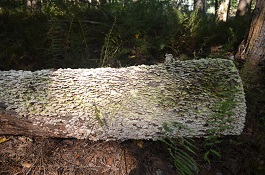
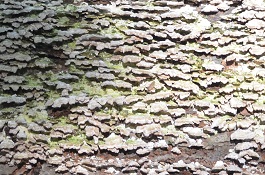
Artist’s Conk or Ganoderma applanatum
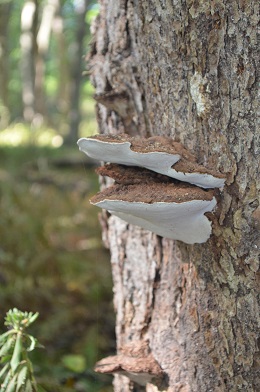
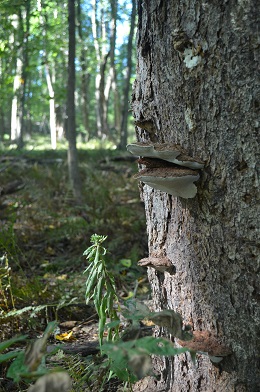
Reishi Mushroom/Lingzhi Mushroom or Ganoderma lucidum
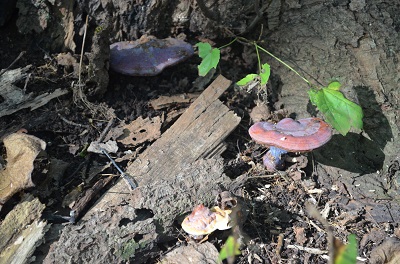
Come check out our next Awesome Autumn Amble on Wednesday 24 at 10 a.m. at Hartshorne Woods Park for more mushrooms! Meet in the Rocky Point section, Highlands. Please note that the Rocky Point parking lot is closed for construction. Participants should park on Portland Road near Grand Tour Road. (posted 10/18/2018)
What is that shore bird with the big orange beak?
It’s an Oystercatcher!
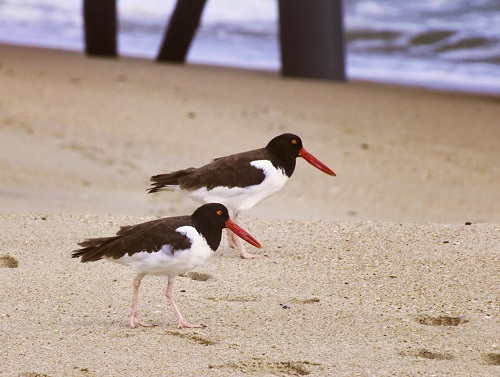
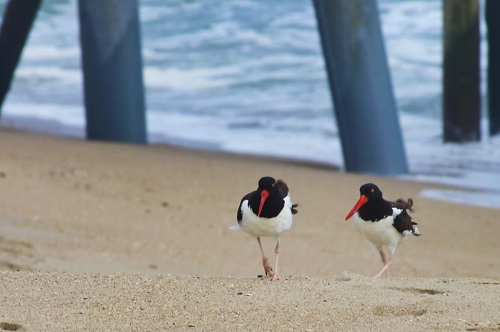
American Oystercatchers are large shore birds with black and white feathers and an out-of-proportionally large beak, making them very easy to identify. They spend the summers in small groups or alone, and gather into flocks over the winter. Even though they share their habitat with thousands of beachgoers, Oystercatchers seem to be doing well and their numbers are steady. They are considered a species of concern, however, due to the impact we have on their habitat. True to their names, they eat oysters by foraging in shallow water. They open the oysters by waiting until the shellfish opens slightly and then jabbing its beak into the opening and cutting the muscles that closes the shell. They will also eat mussels, clams, marine worms, sand crabs, limpets, sea urchins, jellyfish, and other small creatures of the intertidal zone. An interesting tidbit - the oldest known American Oystercatcher was at least 23 years old! (posted 9/27/2018)
White Monarch Mystery at the
Manasquan Reservoir Environmental Center
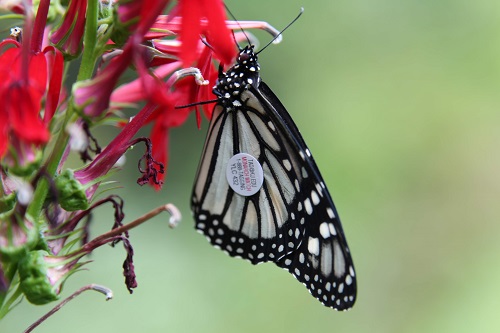
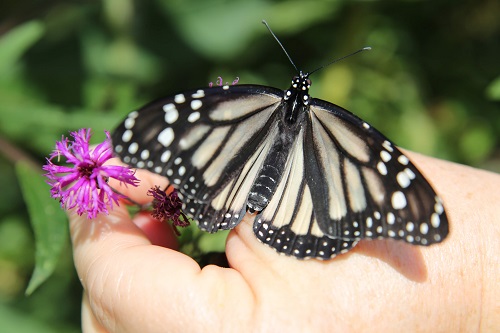
Each morning at the Manasquan Reservoir Environmental Center, staff checks on monarch chrysalides they have been raising to see if new butterflies have emerged. On September 4, staff was amazed to find two white monarchs. Over the next few days they found two more, totaling four.
Monarch butterflies (Danaus pleixppus) are known for their easily recognizable orange and black wings. These markings help warn predators of the monarchs toxicity. White monarchs (Danaus pleixppus nivosis) have grey where the orange color is normally found. White monarchs still have the toxicity to predators but lack the color to warn them away.
These white morphs were the result of a rare recessive gene. While the exact mechanism is not known, one recent study suggests the gene may cause their wing scales to be bent instead of lying flat and neatly overlapping, and this may somehow prevent the deposit of the orange pigment.
It is a very rare event to see white monarchs in the wild. But sometimes when monarchs populations are isolated or inbred the white monarchs appear. So how did the Environmental Center have these butterflies? Usually, staff collect out monarch’s eggs and caterpillars from our gardens or volunteer’s gardens. This year in late August, we received a donation of caterpillars. These caterpillars and resulting butterflies were the result of inbreeding. The four butterflies appeared healthy. Prior to emergence, there was nothing unusual about the caterpillars or chrysalides that would have indicated the surprising color.
The staff tagged the monarchs as part of the Monarch Watch tagging program and notated the coloration. (posted 9/14/2018)
The Eastern Bluebird
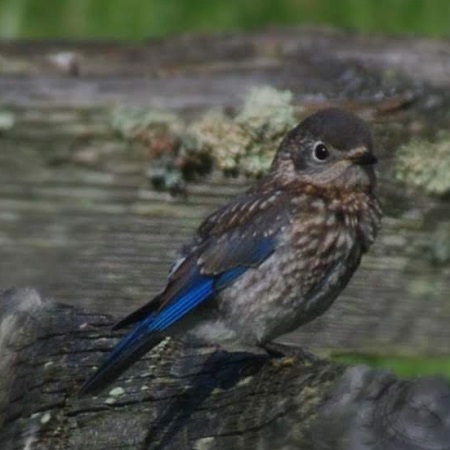
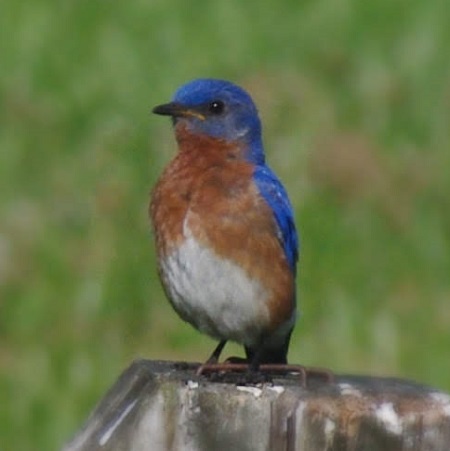
These birds are typical members of a group called “thrushes.” Thrushes are medium-sized birds with soft feathers, plump bodies and alert postures. They have long wings compared to their bodies while their tail and legs are fairly short. Their bills are short and straight as they are predominantly insect eaters. Usually the female, and sometimes the male, have speckled breasts.
Eastern Bluebirds are unique among thrushes when it comes to nest building. They are the only thrush which are cavity nesters. This is why they will easily take up residence in bird houses if they are placed in open areas such as meadows or fields.
Male Eastern Bluebirds are blue with rust breasts and throats. Females are gray and speckled with a blue bar on their wings and tail. Females may have some rust color on their breast as well. These birds are most often seen perched on wires and fence posts as they look for insects. Their population is on the increase due to the many nesting boxes that are being installed along Bluebird Trails, in many public parks, along pastures and even golf courses.
Many of the county parks have habitats where Eastern Bluebirds can be seen. These photos were taken in Holmdel Park, Holmdel. Huber Woods Park, Middletown, is also a great place to see these beautiful birds. (posted 6/27/2018)
Behold This Beetle Beauty!
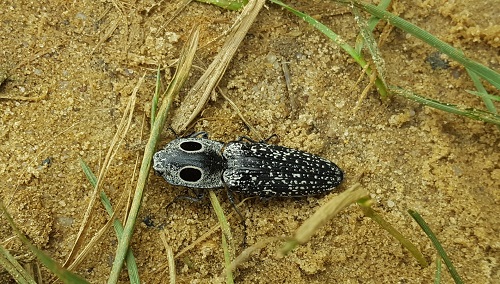
The Eyed Elater, pictured above, is a 1-inch beetle with a remarkable pattern on its shell, also called the Elytra. This insect gets its name from the two false eyespots right below its head. Belonging to the larger family of insects called Click Beetles, this bug can hop a short distance while making a clicking sound. Before you take aim to squash this critter, know that its larval form is a voracious predator and helps keep other beetle populations in check! (posted 6/5/2018)
Red-Winged Blackbird at Freneau Woods Park
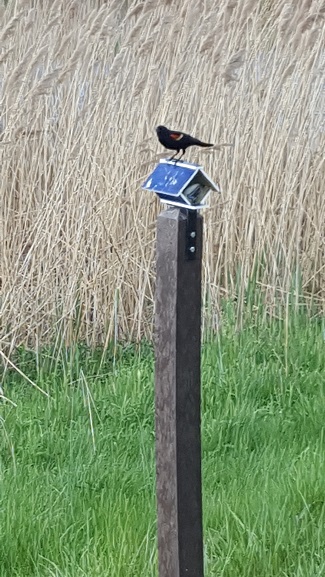
This Red-Winged Blackbird appears to be a fan of our Rockin' the Trails birdhouse! Sporting a brightly colored red and white shoulder patch, the males of this species can often be found perched on high vegetation next to water habitats. During the breeding season, early spring through mid-summer, they will continuously sing out their signature “conk-la-reee” call. (posted 5/8/2018) )
Stinky Heralds of Spring


You know winter is nearing its end when Eastern Skunk Cabbage starts to pop up! The newly emerged plants shown in the photos above were spied during an afternoon stroll along the Marsh Trail in Holmdel Park, Holmdel. Eastern Skunk Cabbage, Symplocarpus foetidus, is easily recognizable by its purple, green, and yellow streaked spathe, the specialized leaves that form a protective hood around its flowers. A peek through the spathe’s small opening shows the club-shaped spadix covered with a cluster of tiny yellow flowers. As both its common and scientific name imply, Skunk Cabbage is a malodorous plant. The stinkiness and bitter taste of its leaves and flowers repel hungry herbivores like deer and rabbits hunting for late winter meals. Not all are repelled by the fetid odors, however. By mimicking decaying flesh, Skunk Cabbage entices carrion loving insects and other early spring pollinators to visit and consequently pollinate its flowers.
Skunk Cabbage’s early arrival in the spring is due in large part to its ability to melt through the frozen ground and snow. As one of a few thermogenic plants, skunk cabbage can produce and regulate its own heat, exceeding the temperature of its surrounding environment. You can imagine that insects and other small creatures would find this warmth inside the hooded spathe inviting (more pollinators!). As spring progresses and the spathes wilt, look for the Skunk Cabbage’s large cabbage like leaves that form pretty carpets of bright green along the wetland areas in our parks. (posted 2/20/2018)
Great Blue Herons:
It is good to see that so many survived the big freeze in January!
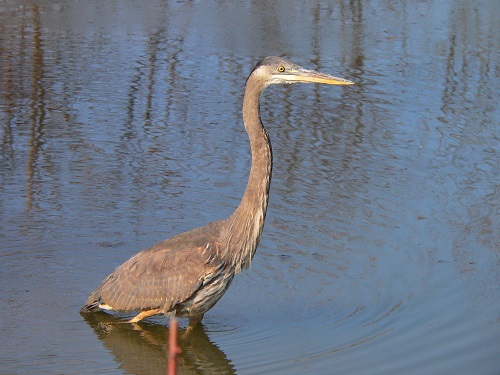
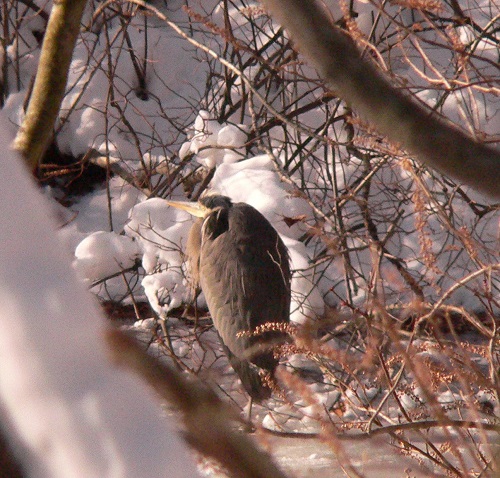
After the long freeze we had in January, it is good to see some of the area’s water birds. Wading birds, such as the Great Blue Heron, need open water to feed. This large wading bird is common in shallow water edge areas of our parks. The largest heron in North American, they are very adaptable and have a range that extends from Canada to South America. They are very shy will usually fly once they have seen you. For wildlife photographers, they are a blessing (when you can get one because they are very photogenic) and a curse (because they are so easily spooked.)
These beautiful birds are hard to mistake for other birds as they have a wingspan of up to 6 and a half feet and can be almost 5 feet tall. They are mostly light gray with some black and rust marking on the head and throat. Their face and neck are usually a lighter gray than their bodies. When in flight, they have a slow wing beat and their long legs hang straight behind them.
Unexpectedly, these birds nest it trees. You wouldn’t think that they could go unnoticed in a tree but their long legs and slender bodies blend in very well with branches making them almost invisible. They build large nests with sticks and grasses. The nest must be large enough to hold 3 to 5 young for about 60 days. If they can’t find a suitable place off the ground, they may nest in reeds on the ground.
It you are anxiously awaiting the chance to get out on the trails, bundle up and head out! It is the perfect time for birding. Great Blue Herons are a common sight as are many interesting, winter-season ducks. Others birds that are here year round are active and easy to spot in the bare branches of winter. If you would like to learn more about native birds, join a Casual Birder walk with a park naturalist. The next session is Thursday, February 22 at 9 a.m. at Hominy Path on Matthews Road adjacent to the Hominy Hill Golf Course.
For those of you who would like to try your hand at photographing birds and other wildlife, there is still room in Sunday’s Photographing Birds and Wildlife class. Register today while space is available. (posted 2/5/2018)
Great Horned Owl
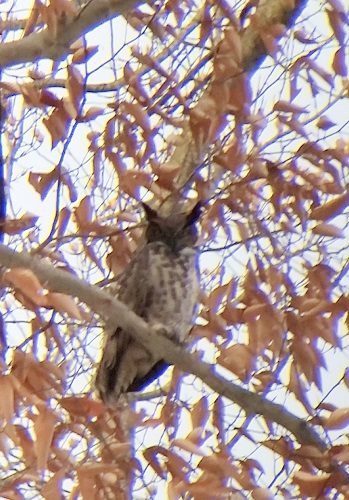
This Great Horned Owl, Bubo virginianus, was found in Big Brook Park, Marlboro. It can be seen resting in a beech tree during the daylight hours, gearing up to go hunting during the night. These owls have specialized feathers atop their heads called “ear tufts.” Often mistaken for horns or ears, these tufts fulfill several roles for the owl, from silent communication between individuals, breaking up their body shape for camouflage, to being used for intimidation against threats. Next time you are walking on a forest trail, listen for the Great Horned Owl’s signature hoots. (posted 1/22/2018)